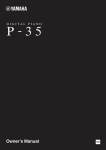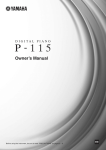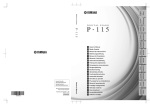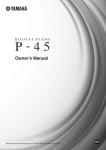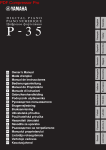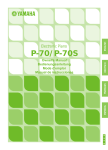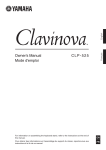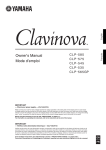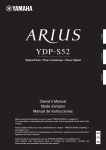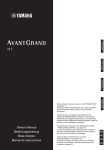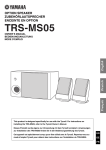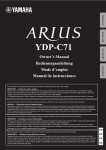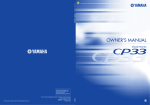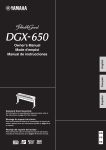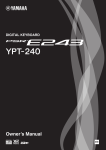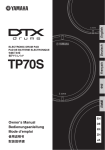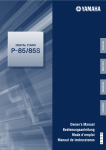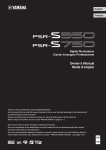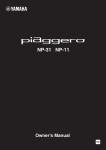Download Yamaha P-105B
Transcript
D I G I TA L P I A N O P-105 Owner’s Manual EN SPECIAL MESSAGE SECTION This product utilizes batteries or an external power supply (adapter). DO NOT connect this product to any power supply or adapter other than one described in the manual, on the name plate, or specifically recommended by Yamaha. WARNING: Do not place this product in a position where anyone could walk on, trip over, or roll anything over power or connecting cords of any kind. The use of an extension cord is not recommended! If you must use an extension cord, the minimum wire size for a 25’ cord (or less ) is 18 AWG. NOTE: The smaller the AWG number, the larger the current handling capacity. For longer extension cords, consult a local electrician. This product should be used only with the components supplied or; a cart, rack, or stand that is recommended by Yamaha. If a cart, etc., is used, please observe all safety markings and instructions that accompany the accessory product. SPECIFICATIONS SUBJECT TO CHANGE: The information contained in this manual is believed to be correct at the time of printing. However, Yamaha reserves the right to change or modify any of the specifications without notice or obligation to update existing units. This product, either alone or in combination with an amplifier and headphones or speaker/s, may be capable of producing sound levels that could cause permanent hearing loss. DO NOT operate for long periods of time at a high volume level or at a level that is uncomfortable. If you experience any hearing loss or ringing in the ears, you should consult an audiologist. IMPORTANT: The louder the sound, the shorter the time period before damage occurs. Some Yamaha products may have benches and / or accessory mounting fixtures that are either supplied with the product or as optional accessories. Some of these items are designed to be dealer assembled or installed. Please make sure that benches are stable and any optional fixtures (where applicable) are well secured BEFORE using. Benches supplied by Yamaha are designed for seating only. No other uses are recommended. Battery Notice: This product MAY contain a small non-rechargeable battery which (if applicable) is soldered in place. The average life span of this type of battery is approximately five years. When replacement becomes necessary, contact a qualified service representative to perform the replacement. This product may also use “household” type batteries. Some of these may be rechargeable. Make sure that the battery being charged is a rechargeable type and that the charger is intended for the battery being charged. When installing batteries, never mix old batteries with new ones, and never mix different types of batteries. Batteries MUST be installed correctly. Mismatches or incorrect installation may result in overheating and battery case rupture. Warning: Do not attempt to disassemble, or incinerate any battery. Keep all batteries away from children. Dispose of used batteries promptly and as regulated by the laws in your area. Note: Check with any retailer of household type batteries in your area for battery disposal information. Disposal Notice: Should this product become damaged beyond repair, or for some reason its useful life is considered to be at an end, please observe all local, state, and federal regulations that relate to the disposal of products that contain lead, batteries, plastics, etc. If your dealer is unable to assist you, please contact Yamaha directly. NAME PLATE LOCATION: The name plate is located on the bottom of the product. The model number, serial number, power requirements, etc., are located on this plate. You should record the model number, serial number, and the date of purchase in the spaces provided below and retain this manual as a permanent record of your purchase. Model NOTICE: Service charges incurred due to a lack of knowledge relating to how a function or effect works (when the unit is operating as designed) are not covered by the manufacturer’s warranty, and are therefore the owners responsibility. Please study this manual carefully and consult your dealer before requesting service. Serial No. Purchase Date ENVIRONMENTAL ISSUES: Yamaha strives to produce products that are both user safe and environmentally friendly. We sincerely believe that our products and the production methods used to produce them, meet these goals. In keeping with both the letter and the spirit of the law, we want you to be aware of the following: 92-BP (bottom) 2 P-105 Owner’s Manual PLEASE KEEP THIS MANUAL Thank you for purchasing this Yamaha Digital Piano! We recommend that you read this manual carefully so that you can fully take advantage of the advanced and convenient functions of the instrument. We also recommend that you keep this manual in a safe and handy place for future reference. Contents Accessories............................................................. 3 About the Manuals .................................................. 4 PRECAUTIONS ...................................................... 4 Introduction Panel Controls and Terminals 6 Setting Up 7 Turning the Power On/Off ....................................... 7 Setting the Volume.................................................. 7 Using Headphones ................................................. 7 Connecting External Audio Equipment ................... 7 Using a Footswitch.................................................. 8 Using the Optional Pedal Unit................................. 8 Reference Selecting & Playing Voices 9 Selecting a Voice .................................................... 9 Layering Two Voices (Dual).................................... 9 Splitting the Keyboard (Split) ................................ 10 Using the Pianist Styles ........................................ 10 Playing Duo........................................................... 11 Adding Variations to the Sound – Reverb............. 12 Setting the Touch Sensitivity................................. 12 Transposing the Pitch in Semitones ..................... 13 Fine-Tuning the Pitch............................................ 13 Listening to the Songs Using the Metronome/Rhythm 15 Selecting a Beat (Time Signature).........................15 Selecting a Rhythm ............................................... 15 Adjusting the Tempo..............................................15 Adjusting the Volume.............................................15 Recording Your Performance 16 Quick Recording .................................................... 16 Recording Independently to Two Parts .................16 Changing the Initial Settings of the Recorded Song..17 Transferring SMF Files Between a Computer and this Instrument ............................................17 Deleting the Entire Song........................................18 Song Playback and Practice 18 Backup Data and Initializing 19 Auto Power Off Function 19 Appendix Troubleshooting 20 Specifications 20 Preset Song List 21 Quick Operation Guide 22 14 Listening to the Demo Songs................................ 14 Listening to the Preset Songs ............................... 14 Accessories • • • • Owner’s Manual AC Power Adaptor* Online Member Product Registration** Footswitch • Music Rest Insert into the slot * May not be included depending on your particular area. Please check with your Yamaha dealer. ** The PRODUCT ID on the sheet will be needed when you fill out the User Registration form. P-105 Owner’s Manual 3 About the Manuals In addition to this Owner’s Manual, the following Online materials (PDF files) are available. Computer-related Operations Contains instructions about computer-related functions. MIDI Reference Contains MIDI-related information, such as the MIDI Implementation Chart. MIDI Basics (only in English, French, German and Spanish) Contains basic explanations about what MIDI is and can do. To obtain the documents above, access the Yamaha Manual Library, enter your model name in the Model Name area, then click [SEARCH]. Yamaha Manual Library http://www.yamaha.co.jp/manual/ PRECAUTIONS PLEASE READ CAREFULLY BEFORE PROCEEDING Please keep this manual in a safe and handy place for future reference. WARNING Always follow the basic precautions listed below to avoid the possibility of serious injury or even death from electrical shock, short-circuiting, damages, fire or other hazards. These precautions include, but are not limited to, the following: Power supply/AC power adaptor Water warning • Do not place the power cord near heat sources such as heaters or radiators. Also, do not excessively bend or otherwise damage the cord, or place heavy objects on it. • Only use the voltage specified as correct for the instrument. The required voltage is printed on the name plate of the instrument. • Use the specified adaptor (page 20) only. Using the wrong adaptor can result in damage to the instrument or overheating. • Do not expose the instrument to rain, use it near water or in damp or wet conditions, place on it any containers (such as vases, bottles or glasses) containing liquids which might spill into any openings. If any liquid such as water seeps into the instrument, turn off the power immediately and unplug the power cord from the AC outlet. Then have the instrument inspected by qualified Yamaha service personnel. • Never insert or remove an electric plug with wet hands. • Check the electric plug periodically and remove any dirt or dust which may have accumulated on it. Fire warning • Do not put burning items, such as candles, on the unit. A burning item may fall over and cause a fire. Do not open • This instrument contains no user-serviceable parts. Do not open the instrument or attempt to disassemble or modify the internal components in any way. If it should appear to be malfunctioning, discontinue use immediately and have it inspected by qualified Yamaha service personnel. If you notice any abnormality • When one of the following problems occur, immediately turn off the power switch and disconnect the electric plug from the outlet. Then have the device inspected by Yamaha service personnel. - The power cord or plug becomes frayed or damaged. - It emits unusual smells or smoke. - Some object has been dropped into the instrument. - There is a sudden loss of sound during use of the instrument. 4 DMI-5 P-105 Owner’s Manual 1/2 CAUTION Always follow the basic precautions listed below to avoid the possibility of physical injury to you or others, or damage to the instrument or other property. These precautions include, but are not limited to, the following: Power supply/AC power adaptor Connections • Do not connect the instrument to an electrical outlet using a multiple-connector. Doing so can result in lower sound quality, or possibly cause overheating in the outlet. • Before connecting the instrument to other electronic components, turn off the power for all components. Before turning the power on or off for all components, set all volume levels to minimum. • When removing the electric plug from the instrument or an outlet, always hold the plug itself and not the cord. Pulling by the cord can damage it. • Be sure to set the volumes of all components at their minimum levels and gradually raise the volume controls while playing the instrument to set the desired listening level. • Remove the electric plug from the outlet when the instrument is not to be used for extended periods of time, or during electrical storms. Handling caution Location • Do not insert a finger or hand in any gaps on the instrument. • Do not place the instrument in an unstable position where it might accidentally fall over. • Before moving the instrument, remove all connected cables, to prevent damage to the cables or injury to anyone who might trip over them. • When setting up the product, make sure that the AC outlet you are using is easily accessible. If some trouble or malfunction occurs, immediately turn off the power switch and disconnect the plug from the outlet. Even when the power switch is turned off, electricity is still flowing to the product at the minimum level. When you are not using the product for a long time, make sure to unplug the power cord from the wall AC outlet. • Never insert or drop paper, metallic, or other objects into the gaps on the panel or keyboard. This could cause physical injury to you or others, damage to the instrument or other property, or operational failure. • Do not rest your weight on, or place heavy objects on the instrument, and do not use excessive force on the buttons, switches or connectors. • Do not use the instrument/device or headphones for a long period of time at a high or uncomfortable volume level, since this can cause permanent hearing loss. If you experience any hearing loss or ringing in the ears, consult a physician. • Use only the stand specified for the instrument. When attaching the stand or rack, use the provided screws only. Failure to do so could cause damage to the internal components or result in the instrument falling over. Yamaha cannot be held responsible for damage caused by improper use or modifications to the instrument, or data that is lost or destroyed. Always turn the power off when the instrument is not in use. Even when the [ ] (Standby/On) switch is in standby status (power lamp is off), electricity is still flowing to the instrument at the minimum level. When you are not using the instrument for a long time, make sure you unplug the power cord from the wall AC outlet. Notice Information To avoid the possibility of malfunction/ damage to the product, damage to data, or damage to other property, follow the notices below. About copyrights Handling and Maintenance • Do not use the instrument in the vicinity of a TV, radio, stereo equipment, mobile phone, or other electric devices. Otherwise, the instrument, TV, or radio may generate noise. • Do not expose the instrument to excessive dust or vibrations, or extreme cold or heat (such as in direct sunlight, near a heater, or in a car during the day) to prevent the possibility of panel disfiguration, damage to the internal components or unstable operation. (Verified operating temperature range: 5° – 40°C, or 41° – 104°F.) • Do not place vinyl, plastic or rubber objects on the instrument, since this might discolor the panel or keyboard. • When cleaning the instrument, use a soft, dry/dry or slightly damp cloth. Do not use paint thinners, solvents, cleaning fluids, or chemical-impregnated wiping cloths. Saving data • Some types of data (page 19) will be stored in internal memory, and maintained even if the power is turned off. However, the data could be lost due to malfunction or incorrect operation. Save important data to a computer. For details, refer to the Computer-related Operations (page 4). DMI-5 • Copying of the commercially available musical data including but not limited to MIDI data and/or audio data is strictly prohibited except for your personal use. • This product incorporates and bundles computer programs and contents in which Yamaha owns copyrights or with respect to which it has license to use others’ copyrights. Such copyrighted materials include, without limitation, all computer software, style files, MIDI files, WAVE data, musical scores and sound recordings. Any unauthorized use of such programs and contents outside of personal use is not permitted under relevant laws. Any violation of copyright has legal consequences. DON’T MAKE, DISTRIBUTE OR USE ILLEGAL COPIES. About functions/data bundled with the instrument • Some of the preset songs have been edited for length or arrangement, and may not be exactly the same as the original. About this manual • The illustrations and LCD screens as shown in this manual are for instructional purposes only, and may appear somewhat different from those on your instrument. • The company names and product names in this manual are the trademarks or registered trademarks of their respective companies. 2/2 P-105 Owner’s Manual 5 Panel Controls and Terminals Introduction q w e u r t y i o !0 !1 !2 !3 !4 Shows the jacks and terminals as seen when viewed from the rear of the instrument. A-1 C0 C1 C2 C3 C4 C5 C6 C7 Built-in Speakers !5 q[ ] (Standby/On) switch ....................... page 7 For turning the power on or setting to standby. w [MASTER VOLUME] slider..................... page 7 For adjusting the volume of the entire sound. e [DEMO/SONG] button ...........................page 14 For playing the Demo Songs and the Preset Songs. r TEMPO [][]/SELECT [][]buttons ................................................................page 14 For selecting a Song during playback, adjusting the tempo, and selecting the Song part for recording and playback. t [METRONOME/RHYTHM] button..........page 15 For starting or stopping the metronome or rhythm. y [PIANIST STYLE] button .......................page 10 For using the Pianist Styles. u [REC] button ..........................................page 16 For recording your keyboard performance. i [PLAY] button ........................................page 16 For playing back the recorded performance. o Voice buttons.......................................... page 9 For switching the Voice between those printed above and below each button. 6 P-105 Owner’s Manual Speakers are built into the instrument at the bottom. Though you can enjoy playing the instrument even when putting it on a desk or table, we recommend that you use an optional keyboard stand for better sound. For selecting a Voice or two Voices played simultaneously, such as Piano and Organ. !0 [USB TO HOST] terminal For connecting to a computer, allowing you transfer the User Song data as SMF, and transmit MIDI messages between both devices. For details, refer to the “Computer-related Operations” and the “MIDI Reference.” NOTICE • Use an AB type USB cable of less than 3 meters. USB 3.0 cables cannot be used. !1 [SUSTAIN] jack ........................................page 8 For connecting the included footswitch, an optional footswitch and foot pedal. !2 [PEDAL UNIT] jack ..................................page 8 For connecting an optional pedal unit. !3 AUX OUT [L/L+R][R] jacks .....................page 7 For connecting external audio equipment. !4 DC IN jack ................................................page 7 For connecting the power adaptor. !5 [PHONES] jacks ......................................page 7 For connecting a set of standard stereo headphones. Setting Up Turning the Power On/Off 1 Connect the AC power adaptor to the DC IN jack. WARNING • Use only the specified adaptor (page 20). Using the wrong adaptor can result in damage to the instrument or overheating. 2 Plug the AC power adaptor into an AC outlet. 3 Press the [ ] (Standby/On) switch to turn on the power. The power lamp located to the left of the [ ] (Standby/On) switch lights up. To turn off the power, press this switch again. CAUTION • Even when the [ ] (Standby/On) switch is in standby status (power lamp is off), electricity is still flowing to the instrument at the minimum level. When you are not using the instrument for a long time, make sure you unplug the power cord from the wall AC outlet. I.A. Control (Intelligent Acoustic Control) With this function, the sound quality of this instrument is automatically adjusted and controlled according to the overall volume. Even when the volume is low, you can hear both low sounds and high sounds clearly. To turn on/off the I.A. Control: While holding down [DEMO/SONG] and [METRONOME/RHYTHM] simultaneously, press the C#5 key to turn on or D5 to turn off. The default setting is “on”. To adjust the I.A. Control Depth: While holding down [DEMO/SONG] and [METRONOME/RHYTHM] simultaneously, press the A#4 key to decrease by one, C5 to increase by one, or B4 to reset to 0 (default). The setting range is from -3 to +3. For details on the key assignments, see “Quick Operation Guide” (page 22). Using Headphones Since this instrument is equipped with two [PHONES] jacks, you can connect two sets of standard stereo headphones. If you are using only one set of headphones, insert a plug into either jack, shutting off the speakers. 1 2 AC power adaptor AC outlet 3 Standard stereo phone plug CAUTION IMPORTANT • Note that the power is automatically turned off if this instrument is not operated for 30 minutes. For details, see page 19. • To protect your hearing, avoid listening with the headphones at a high volume level for long periods of time. Connecting External Audio Equipment Setting the Volume When you start playing, use the [MASTER VOLUME] slider to adjust the volume of the entire keyboard sound. To amplify the instrument’s sound, you can connect a stereo system to the AUX OUT [L/L+R]/[R] jacks via the Phone plugs (standard). The volume of the sound output from those jacks will be adjusted via the [MASTER VOLUME] slider. NOTICE Decreases. Increases. • When the instrument’s sound is output to an external device, first turn on the power to the instrument, then to the external device. Reverse this order when you turn the power off. NOTE • Use audio cables and adaptor plugs having no (zero) resistance. • Use only the [L/L+R] jack for connection with a monaural device. P-105 Owner’s Manual 7 Setting Up Damper (Right) Pedal Using a Footswitch The [SUSTAIN] jack is for connecting the included footswitch, which works in the same way as a damper pedal on an acoustic piano. Also an optional FC3 foot pedal or FC4/FC5 footswitch can be connected to this jack. The FC3 lets you use the Half Pedal function. Pressing this pedal will sustain notes longer. Releasing this pedal immediately stops (damps) any sustained notes. A “half-pedal” function of this pedal creates partial sustain effects, depending on how far down you press the pedal. If you press and hold the damper pedal here, all the notes shown will be sustained. Half Pedal function (for FC3 and LP-5A/LP5AWH) If you are playing the piano with sustain and want a clearer, less muddled sound (especially in the bass register), let up on your foot from the pedal to half position or higher. NOTE • Do not press the footswitch when turning the power on. Doing this changes the recognized polarity of the footswitch, resulting in reversed footswitch operation. Damper Resonance This function simulates the sustain sound produced via the damper pedal on a grand piano. To turn on/off the Damper Resonance: While holding down [DEMO/SONG] and [METRONOME/RHYTHM] simultaneously, press the G4 key (on; default) or G#4 key (off). G#4 (off) • Make sure that power is OFF when connecting or disconnecting the footswitch or pedal. G4 (on) Using the Optional Pedal Unit The [PEDAL UNIT] jack is for connecting an optional LP-5A/LP-5AWH pedal unit. When connecting the pedal unit, make sure to also assemble the unit on an optional keyboard stand (L-85/L-85S/L85WH). LP-5A/ LP-5AWH (optional) Sostenuto (Center) Pedal If you play a note or chord on the keyboard and press the sostenuto pedal while the note(s) are held, those notes will sustain as long as you hold the pedal (as if the damper pedal had been pressed) but all subsequently played notes will not be sustained. This makes it possible to sustain a chord, for example, while other notes are played “staccato.” L-85/L-85S/ L-85WH (optional) If you press and hold the sostenuto pedal here, only the notes held at this timing will be sustained. Soft (Left) Pedal NOTE • Make sure that power is OFF when connecting or disconnecting the pedal unit. • The Damper Resonance cannot be used in Duo (page 11). The soft pedal reduces the volume and slightly changes the timbre of notes played while the pedal is pressed. The soft pedal will not affect notes that are already playing when it is pressed. NOTE • When you select the JAZZ ORGAN or ROCK ORGAN Voice, the Left pedal functions to switch the rotary speed of the rotary speaker. 8 P-105 Owner’s Manual Selecting & Playing Voices Reference 2 Selecting a Voice NOTE The instrument has a wide variety of Voices, or instrument sounds, for your enjoyment, including Piano and Organ. 1 Press a Voice button once or twice. Pressing the same Voice button repeatedly alternates the on/off status of the lamp, changing between the Voices whose names are printed above (lamp off) and below (lamp on) the buttons. Lamp Play the keyboard. • To familiarize yourself with the characteristics of the voices, listen to the demo songs for each voice (page 14). • You can shift the Octave as described in the next column (see “Voice 1”). Layering Two Voices (Dual) You can play Voices simultaneously across the entire range of the keyboard. Note that the Voice of the left side button is designated as Voice 1, while the Voice of the right side button is designated as Voice 2. NOTE • Two Voices of the same button cannot be layered (for example, STRINGS and HARPSICHORD). Voice List Voice Name Description Sampled from a concert grand piano. It uses different samples depending on the playing strength and produces smoother GRAND PIANO 1 tonal changes. Suitable not only for classical compositions but also for any style music. GRAND PIANO 2 Spacious and clear piano with bright reverb. Good for popular music. E. PIANO 1 An electronic piano sound created by FM synthesis. Good for standard popular music. E. PIANO 2 A slightly brighter electronic piano sound than E. PIANO 1. Good for standard popular music. E. PIANO 3 Vintage electric piano sound of hammerstruck metallic “tines.” Soft tone when played lightly, and an aggressive tone when played hard. E. PIANO 4 Another vintage electric piano sound different from E. PIANO 3 often heard in rock and popular music. JAZZ ORGAN A “tonewheel” type electric organ. Often heard in jazz and rock music. PIPE ORGAN A typical pipe organ sound (8 feet + 4 feet + 2 feet). Good for sacred music from the Baroque period. ROCK ORGAN Bright and edgy electric organ sound. Good for rock music. VIBRAPHONE Played with relatively soft mallets. The tone becomes more metallic the harder you play. STRINGS Stereo-sampled, large-scale strings ensemble with realistic reverb. Try combining this Voice with piano in the Dual mode. HARPSICHORD The definitive instrument for baroque music. Authentic harpsichord sound, with plucked strings, no touch response, and characteristic key-release sound. WOOD BASS An upright bass played fingerstyle. Ideal for jazz and Latin music. E. BASS For a wide range of music styles, jazz, rock, popular, and more. 1 Engage Dual. Press the desired Voice button once or twice (depending on the desired Voice), then while holding down that button, press the other Voice button once or twice. When the lamp is off, the Voice printed above the button is selected; when the lamp is on, the Voice printed below is selected. When the buttons are released, Dual is engaged. The lamp indicates the status of the Voice 1 selection. Lamp Voice 1 2 Voice 2 Play the keyboard to enjoy the dual sound. To shift the Octave for each Voice: To shift Voice 1, simultaneously hold down [METRONOME/RHYTHM] and press the A4 key to lower by one, B4 to raise by one, or A#4 to reset to the default setting. For Voice 2, simultaneously hold down [METRONOME/RHYTHM] and press the C5 key to lower by one, D5 to raise by one, or C#5 to reset to the default setting. The setting range is from -3 to +3 for both Voices. Voice 1 Voice 2 A4 D5 P-105 Owner’s Manual 9 Selecting & Playing Voices To adjust the balance between two Voices: To shift the Octave for each Voice: While holding down [METRONOME/ RHYTHM], press the E5 key to decrease by one, F#5 to increase by one, or F5 to reset to the default setting. The setting range is from -6 to +6. Settings above the default increase the volume of Voice1, and vice versa. Same as in Dual (page 9). To adjust the volume balance between two Voices: Same as in Dual (see column at left). To change the Split Point: F#5 (+1) E5 (-1) 3 F5 (Default) To exit from Dual, simply press any Voice button. Splitting the Keyboard (Split) You can play different Voices your left and right hands. 1 While holding [L], press the desired key. While holding [L], press a Voice button to engage Split. The Left Voice (Voice 2) is selected. The keyboard is divided into the two sections with the F#2 key as the Split Point. 3 To exit from Split, simply press any Voice button. Using the Pianist Styles You can automatically play arpeggio-like rhythms by specifying the chord type with your left hand, while playing a melody with your right hand. 1 Press [PIANIST STYLE] so that the lamp flashes. The keyboard is divided into the Chord section (Left) and Melody section (Right). Split Point (Default: F#2) Split Point (Default: F#2) Chord section Left Voice (Voice 2) NOTE • Only Dual or Split can be called up; both cannot be used together. 2 Melody section Right Voice (Voice 1) To change the Right Voice (Voice 1) in this status, select a Voice while holding [R]. 2 While holding [PIANIST STYLE], press a key from the E2 – C#3 to select the desired Style. For details on which Pianist Style is assigned to each key, see “Quick Operation Guide” (page 22). C#3 E2 10 P-105 Owner’s Manual Selecting & Playing Voices 3 Play a chord with your left hand to start playback of the Pianist Style. Play a melody with your right hand, along with the chords you play. G6 NOTE • For details on how to play Chords, refer to commercially available chord books. Equivalent to C3 (middle C) Split Point Equivalent to C3 (middle C) To change the tempo: Basically, this is the same as Metronome tempo (page 15). In addition, you can change the tempo also by pressing the specified keys while holding [PIANIST STYLE]. For details about the key assignment, refer to the Quick Operation Guide (page 22). Left Voice (Voice 2) • The Split Point cannot be changed from E3. • If the keyboard is in Dual, engaging Duo will exit from Dual. The Voice 1 is used as the Voice of the entire keyboard. To adjust the Pianist Style Volume: While holding down [PIANIST STYLE], press one of the A-1 – F#0 keys. The higher the key, the higher the volume. The default value is 7 (D#-1). Right Voice (Voice 1) NOTE 2 F#0 One person should play the left section of the keyboard while the other plays the right. To change the Left Voice: While holding down [L], press a Voice button once or twice. A-1 To change the Right Voice: While holding down [R], press a Voice button once or twice. NOTE • Refer to the numbers 1 – 10 printed in the VOLUME section above the keyboard. 4 To change the Right and Left Voices to the same single Voice: Press [PIANIST STYLE] to stop playback. The lamp turns off, and the keyboard returns to the original status. Simply press the Voice button once or twice. To shift the Octave for each Voice: Same as in Dual (page 9). To change the Split Point: To adjust the volume balance between two keyboard sections: Same as in Split (page 10). Same as in Dual (page 10). Pedal function in Duo Playing Duo The Footswitch connected to the [SUSTAIN] jack affects both Right and Left sections. The optional Pedal unit (page 8) functions as follows: • Damper Pedal: Applies Sustain to the right section. • Sostenuto Pedal: Applies Sustain to both sections. • Soft Pedal: Applies Sustain to the left section. This function allows two different players to play the instrument, one on the left and the other on the right, over the same octave range. 1 While holding down [DEMO/SONG] and [METRONOME/RHYTHM] simultaneously, press the G6 key to engage Duo. The keyboard is divided into two sections, with the E3 key as the Split Point. 3 To exit from Duo, press the G6 key while holding [DEMO/SONG] and [METRONOME/RHYTHM] simultaneously. P-105 Owner’s Manual 11 Selecting & Playing Voices Adding Variations to the Sound – Reverb This instrument features several Reverb Types that add extra depth and expression to the sound to create a realistic acoustic ambience. Although the appropriate Reverb Type is called up automatically when you select each of the Voices, Songs, and Pianist Styles, you can change the Reverb Type. Setting the Touch Sensitivity You can specify the degree of Touch Sensitivity (how the sound responds to your playing strength). While holding down [DEMO/SONG] and [METRONOME/RHYTHM], press one of the A6 – C7 keys. A6 C7 To select a Reverb Type: While holding down [METRONOME/RHYTHM], press one of the G#6 – C7 keys. G#6 C7 Key Touch Sensitivity A6 Fixed The volume level does not change at all regardless of whether you play the keyboard soft or hard. A#6 Soft The volume level does not change much when you play the keyboard soft or hard. B6 Medium This is the standard piano touch response (default setting). Hard The volume level changes very widely from pianissimo to fortissimo to facilitate dynamic and dramatic expression. You have to hit the keys hard to produce a loud sound. Reverb Type List Key Reverb Type Description G#6 Room Adds a continuous reverb effect to the sound, similar to the acoustic reverberation you would hear in a room. A6 Hall1 For a bigger reverb sound. This effect simulates the natural reverberation of a small-size concert hall. A#6 Hall2 For a truly spacious reverb sound. This effect simulates the natural reverberation of a large concert hall. B6 Stage Simulates the reverb of a stage environment. C7 Off No effect is applied. To adjust Reverb Depth: While holding down [METRONOME/RHYTHM], press the F6 key to decrease by one, G6 to increase by one, or F#6 to reset to the default value (most suitable value for the current Voice). The higher the value, the deeper the effect. The setting range is from 0 (no effect) – 20 (maximum depth). F#6 (Default) F6 (-1) 12 P-105 Owner’s Manual G6 (+1) C7 Description NOTE • The touch sensitivity settings may have little or no effect with JAZZ ORGAN, ROCK ORGAN, PIPE ORGAN and HARPSICHORD–voices that are not normally responsive to keyboard dynamics. Selecting & Playing Voices Transposing the Pitch in Semitones You can shift the pitch of the entire keyboard up or down in semitones in order to facilitate playing in difficult key signatures, or to easily match the pitch of the keyboard to the range of a singer or other instruments. For example, if “+5” is selected, playing key C produces pitch F, letting you play a song of F major as though it were in C major. Fine-Tuning the Pitch You can fine tune the pitch of the entire instrument in approximately 0.2 Hz increments. This lets you match the keyboard pitch finely to that of other instruments or CD music. To lower the pitch: While holding down [DEMO/SONG] and [METRONOME/RHYTHM], press the C#0 key repeatedly to lower the pitch in approximately 0.2 Hz increments. To transpose the pitch down: While holding down [DEMO/SONG] and [METRONOME/RHYTHM], press a key between F#3 (-6) and B3 (-1). To transpose the pitch up: While holding down [DEMO/SONG] and [METRONOME/RHYTHM], press a key between C#4 (+1) and F#4 (+6). To restore the original pitch: While holding down [DEMO/SONG] and [METRONOME/RHYTHM], press the C4 key. F#3 F#4 To raise the pitch: While holding down [DEMO/SONG] and [METRONOME/RHYTHM], press the D0 key repeatedly to raise the pitch in approximately 0.2 Hz increments. To reset the pitch to the default (A3 = 440 Hz): While holding down [DEMO/SONG] and [METRONOME/RHYTHM], press the B-1 key. To set the pitch to A3 = 442 Hz: While holding down [DEMO/SONG] and [METRONOME/RHYTHM], press the C0 key. C#0 (-0.2 Hz) C4 B-1 (440.0 Hz) D0 (+0.2 Hz) C0 (442.0 Hz) NOTE • The setting range is from 427.0 Hz to 453.0 Hz. The default setting is A3 = 440.0 Hz. P-105 Owner’s Manual 13 Listening to the Songs 2 Listening to the Demo Songs Special individual Demo Songs are provided for all of the Voices of the instrument. 1 While holding down [DEMO/SONG], press one of the desired Voice buttons once or twice, then release the buttons to start playback. Pressing the same Voice button repeatedly alternates the on/off status of the lamp, changing between the Voices whose names are printed above (lamp off) and below (lamp on) the buttons. After selecting a Voice, release both buttons to start playback. A Demo Song for each Voice will play back in sequence (from left to right). Press [DEMO/SONG] again to stop playback. Listening to the Preset Songs In addition to the Demo Songs, Preset Songs are provided for your listening pleasure. Choose a Song from the Preset Song List on page 21, then follow the instructions below. 1 While holding down [DEMO/SONG], press one of the C2 – C#6 keys to start playback. Each of the Preset Songs is assigned to each of these keys. For details on assignment, see “Quick Operation Guide” (page 22). Lamp NOTE 1st Song • Simply pressing [DEMO/SONG] will start playback of all Demo Songs from the first (Grand Piano 1) in sequence. 10th Song 20th Song 30th Song 40th Song 50th Song To change the Demo Song during playback: • Select another Voice. For details on selecting a Voice, refer to page 9. • Press SELECT [] or [] to call up the previous or next Demo Song. C2 C3 C4 C5 C6 The Preset Songs will play back in sequence. To change to another Song during playback: • While holding down [DEMO/SONG], press one of the C2 – C#6 keys. • Press SELECT [] or [] to call up the previous or next Demo Song. To adjust the playback tempo: While holding down [METRONOME/ RHYTHM], press TEMPO [] or [] to decrease or increase by one. To adjust the playback tempo: While holding down [METRONOME/ RHYTHM], press TEMPO [] or []. Demo Song List Voice Name Title Composer Herr Christ, der ein’ge Gottes-Sohn, PIPE ORGAN BWV.601 J.S. Bach HARPSICHORD J.S. Bach Concerto a cembalo obbligato, 2 violini, violae continuo No.7, BWV.1058 The demonstration pieces listed above are short rearranged excerpts of the original compositions. All other songs are original (© 2012 Yamaha Corporation). 14 P-105 Owner’s Manual 2 Press [DEMO/SONG] again to stop playback. Using the Metronome/Rhythm The Metronome is convenient for practicing with an accurate tempo. The Metronome sound features several rhythms as well as the conventional click sound. 1 Press [METRONOME/RHYTHM] to start the Metronome. Adjusting the Tempo To increase or decrease the value by 1: 2 When the Metronome/Rhythm is playing back, press TEMPO [] or []. When it is stopped, press TEMPO [] or [] while holding down [METRONOME/RHYTHM]. Press [METRONOME/RHYTHM] again to stop the Metronome. Selecting a Beat (Time Signature) To increase or decrease the value by 1 or 10: While holding down [METRONOME/RHYTHM], press one of the D#4 – G4. D#4 (-10) F#4 (+1) While holding down [METRONOME/RHYTHM], press one of the A0 – D1 keys or one of the Voice buttons. E4 (-1) G4 (+10) F4 (Default) * Refer to the “TEMPO” section printed above these keys. A0 D1 To reset the value to the default (120): *Refer to the “METRONOME” section printed above these keys. No beat 2 3 4 5 6 Beat When the Metronome/Rhythm is playing back, press both TEMPO [] and [] simultaneously. When it is stopped, press both TEMPO [] and [] simultaneously or press the F4 key while holding down [METRONOME/RHYTHM]. To specify a three-digit value: While holding down [METRONOME/RHYTHM], press a key of F3 – D4 one by one. For example, press the F3 (0), D4 (9) and A#3 (5) keys in order to specify “95.” NOTE • When a Rhythm is selected, the Beat cannot be changed. NOTE • Refer to the “TEMPO” section printed above these keys. Selecting a Rhythm While holding down [METRONOME/RHYTHM], press one of the E1 – C#2 keys. C#2 E1 Adjusting the Volume While holding down [METRONOME/RHYTHM], press the desired key between the A-1 (left-most key) and F#0 key. The higher the key, the higher the volume. The setting range is from 1 – 10 and the default value is 7. NOTE For details on which Rhythm number is assigned to each key, see “Quick Operation Guide” (page 22). • Refer to the “VOLUME” section printed above the keys. P-105 Owner’s Manual 15 Recording Your Performance You can record your keyboard performance as a User Song in SMF format. Up to two Parts (L and R) can be recorded separately. NOTICE • Note that the Recording operation will replace the already recorded data with the new data, since only one User Song is available. Before recording, check the [PLAY] lamp lights (data available) or not (no data). If you save the recorded data, transfer it to the computer as a SMF file. For details, refer to “Computer-related Operations” (page 4). 4 Press either [REC] or [PLAY] to stop recording. The [REC] and [PLAY] lamps flash, indicating that the recorded data is being stored. After Store is completed, the [REC] lamp turns off. NOTICE • Never turn off the power while the recorded data is being stored (while the lamps are flashing). Otherwise, all recorded data will be lost. Quick Recording 1 2 Before recording, make the settings such as Voice and Beat. Because some of the settings cannot be changed after the Record mode is engaged, make the settings according to your performance preferences. For example, if you want to record your performance with a Pianist Style, turn on [PIANIST STYLE]. 5 To hear the recorded Song, press [PLAY] to start playback. Press [PLAY] again to stop playback. Part Assignment When either the Pianist Style or Split/Duo is used for recording, the data as listed below will be recorded to each part. Press the [REC] to engage Record Ready mode. The [REC] lamp will flash according to the current tempo. If necessary, set the tempo (page 15). L part R part When Pianist Style is on: Chord change in the left hand section Keyboard performance in the right hand section When Split or Duo is on: Keyboard performance in the left hand section Keyboard performance in the right hand section NOTE • You cannot engage Record mode while a song is playing. • You can use the Metronome/Rhythm while recording; however, the Metronome/Rhythm sound will not be recorded. When you record the Pianist Style performance, the Metronome/Rhythm cannot be played back while recording. 3 Play the keyboard or press [PLAY] to start recording. The [REC] lamp lights up while the [PLAY] lamp flashes at the current tempo. Recording Independently to Two Parts You can record your performance to the L part (left hand part) and R part (right hand part) separately. NOTICE • If you select a Part containing data, the Recording operation will replace the already-recorded data with the new data. NOTE Play the keyboard and record your performance. 16 P-105 Owner’s Manual • If you want to record your performance using Pianist Style, Split or Duo, use the Quick Recording method (in the previous section), since the instructions below do not apply to these functions. 1 Before recording, make the settings such as Voice and Beat. 2 While holding down [REC], press [R] or [L] for the part you want to record, to engage Record ready Mode. Recording Your Performance To record the right part ([R]): Changing the Initial Settings of the Recorded Song The following parameter settings of the Song can be changed after the Record operation is completed. For individual parts: Voice, Balance, Reverb Depth, Pedal (Damper/ Soft) To record the left part ([L]): For the entire Song: Tempo, Reverb Type, Pianist Style Volume After a while, the [REC] lamp will flash at the current tempo. If necessary, set the tempo (page 15). 1 Make the settings of the above parameters. 2 While holding down [REC], press the desired Part button to engage Record Ready mode. If you want to change the value of the parameters shared by two parts, select either part. If data has already been recorded to the other Part: The data in this Part will be played back while recording. This Part can be turned off or on by pressing this Part button while holding down [PLAY]. NOTICE • In this status, do not press [PLAY] again or any key. Otherwise, recording starts and the data will be deleted. NOTE • You can use the Metronome/Rhythm while recording; however, the Metronome/Rhythm sound will not be recorded. 3 Start recording. Play the keyboard or press [PLAY] to start recording. The [REC] lamp lights up while the [PLAY] lamp flashes at the current tempo. 4 Press either [REC] or [PLAY] to stop recording. The [REC] and [PLAY] lamps flash, indicating that the recorded data is being stored. After the operation is completed, the [REC] lamp will be turned off. NOTICE • Never turn off the power while the recorded data is being stored (while the lamps are flashing). Otherwise, all recorded data will be lost. 5 If desired, record the other part by repeating Steps 1 – 4. 6 To hear the recorded Song, Press [PLAY] to start playback. Press [PLAY] again to stop playback. 3 Press [REC] again to change the initial settings and to exit from Record Ready mode. Transferring SMF Files Between a Computer and this Instrument With Musicsoft Downloader (available for free downloading), a SMF file can be transferred between the computer and the User Song memory area of this instrument. For details, refer to the “Computer-related Operations” downloadable from Yamaha Manual Library (page 4). NOTICE • Before you transfer an SMF file from a computer, make sure to transfer the User Song to a computer for safe keeping, since already-recorded data will be replaced with the new transfer. P-105 Owner’s Manual 17 Recording Your Performance Deleting the Entire Song 1 Press [REC] to engage Record Ready mode. The [REC] lamp will flash. 2 While holding down [PLAY], press [REC] so that both the lamps flash. To exit from this status, press any other button such as [DEMO/SONG]. 3 To delete a specific Part: 1 While holding down [REC], press [L] or [R] to engage the Record Ready mode. The [REC] lamp will flash. 2 Press [PLAY] to start recording without playing the keyboard. 3 Press [REC] or [PLAY] to stop recording. All data recorded for the selected Part will be deleted, and the lamp turns off. Press [PLAY], [REC], [L] or [R] to delete the data of the entire Song. After the operation is completed, both lamps turn off. Song Playback and Practice All the Songs except for the Demo (page 14) let you turn on or off the [L] and [R] parts individually. By turning off [R], for example, you can practice the [R] part while the [L] part is playing back, and vice versa. 1 2 18 Start playback of the desired Song. To start the User Song, press [PLAY]. To start the Preset Song, press one of the C2 – C#6 keys to start playback while holding down [DEMO/ SONG]. For details on what Song number is assigned to each key, see “Quick Operation Guide” (page 22). While holding down [PLAY], press [L] or [R] repeatedly to turn the Part on/off. P-105 Owner’s Manual 3 Practice the part which is turned off. 4 Press [PLAY] to stop playback. NOTE • Selecting another Song will cancel the on/off status of the parts. Backup Data and Initializing The following data will be maintained as backup data even if you turn off the power. Backup data Metronome/Rhythm Volume, Metronome/Rhythm selection (Beat or Rhythm number), Touch Sensitivity, Tuning, Split Point, Pianist Style Volume, Auto Power OFF, Damper Resonance on/off, I.A.Control on/off, I.A.Control Depth, User Song To save the User Song data to a computer: Among the backup data listed above, only the User Song data can be transferred to a computer and saved as a SMF file. For details, refer to “Computer-related Operations” on the website. To initialize the backup data: While holding down the C7 key (right-most key), turn the power on to initialize the backup data to the factory initial settings. C7 Both the [REC] and [PLAY] lamps flash, indicating that the initialization is being executed. After the operation is completed, both lamps turn off. NOTICE • Never turn off the power while the initialization is being executed. NOTE • If this instrument somehow malfunctions or fails to operate properly, try executing the initialization. Auto Power Off Function To prevent unnecessary power consumption, this function automatically turns the power off if no buttons or keys are operated for approximately 30 minutes. If desired, you can disable or enable this function. To disable Auto Power Off: To enable Auto Power Off: When the instrument is turned off: While holding down the lowest key, press the [ ] (Standby/On) switch to turn on the power so that the power indicator flashes three times, after which the Auto Power Off is disabled. While holding down [DEMO/SONG] and [METRONOME/RHYTHM] simultaneously, press the A#-1 key. A#-1 A-1 When the instrument is turned on: While holding down [DEMO/SONG] and [METRONOME/RHYTHM] simultaneously, press the A-1 key. A-1 P-105 Owner’s Manual 19 Troubleshooting Problem Appendix Possible Cause and Solution The instrument does not turn on. The instrument has not been plugged in properly. Securely insert the female plug into the jack on the instrument, and the male plug into a proper AC outlet (page 7). The instrument is automatically turned off even if no operation is done. This is normal. This occurs due to the Auto Power Off function (page 19). Noise is heard from the speakers or headphones. The noise may be due to interference caused by the use of a mobile phone in close proximity to the instrument. Turn off the mobile phone, or use it further away from the instrument. The Master Volume is set too low; set it to an appropriate level using the [MASTER VOLUME] slider (page 7). The overall volume is low, or no sound is heard. Make sure a pair of headphones is not connected to the headphones jack (page 7). Make sure that Local Control is ON. For details, refer to “MIDI Reference” (page 4) on the website. The pedal has no effect. The pedal cable/plug may not be properly connected. Make sure to securely insert the pedal plug into the [SUSTAIN] or [PEDAL UNIT] jack (page 8). The footswitch (for sustain) seems to produce the opposite effect. For example, pressing the footswitch cuts off the sound and releasing it sustains the sounds. The polarity of the footswitch is reversed because the footswitch was pressed when the power was turned on. Turn off the power and turn it on again to reset the function. Make sure to not press the footswitch when turning the power on. Specifications Dimensions (W x D X H) • 1,326 x 295 x 163 mm (52-3/16” x 11-5/8” x 6-7/16”) Weight • 11.7 kg (25 lbs. 13 oz.) Keyboards • 88 keys (A-1 – C7) • Graded Hammer Standard (GHS) keyboard • Touch Sensitivity (Hard/Medium/Soft/Fixed) Voice • 14 Preset Voices • Polyphony: 128 Effects/Functions • • • • • • 4 Reverb types Damper Resonance Dual Split Duo Intelligent Acoustic Control Pianist Style • 10 Styles Song Playback • 14 Demo Songs + 50 Preset Songs Song Recording • 1 User Song with 2 tracks • Data Capacity: One song 100KB (about 11,000 notes) • Format Playback: SMF (format 0, format 1) Recording: SMF (format 0) Overall Functions • • • • 20 Transpose Fine Tuning: 427.0 Hz – 453.0 Hz Metronome/10 Rhythms Tempo (5 – 280) P-105 Owner’s Manual Connectivity • DC IN (12V), PHONES (2), SUSTAIN, PEDAL UNIT, USB TO HOST, AUX OUT Amplifiers •7W+7W Speakers • 12 cm x 2 + 5 cm x 2 Power Supply • AC Power Adaptor PA-150 or an equivalent recommended by Yamaha Power Consumption • 7W (When using PA-150 power adaptor) Included Accessories • Owner’s Manual, Music Rest, AC Power Adaptor PA-150 or an equivalent recommended by Yamaha*, Online Member Product Registration**, Footswitch * May not be included depending on your particular area. Please check with your Yamaha dealer. ** The PRODUCT ID on the sheet will be needed when you fill out the User Registration form. Options • Keyboard Stand L-85/L-85S/L-85WH, Pedal Unit (LP-5A/LP5AWH), Foot Pedal FC3, Footswitch FC4/FC5, Headphones (HPE-30/HPE-150), AC Power Adaptor (Users within U.S or Europe: PA-150 or an equivalent recommended by Yamaha, Others: PA-5D, PA-150 or an equivalent) * Specifications and descriptions in this owner’s manual are for information purposes only. Yamaha Corp. reserves the right to change or modify products or specifications at any time without prior notice. Since specifications, equipment or options may not be the same in every locale, please check with your Yamaha dealer. Preset Song List No. Title Composer 1 Invention No. 1 J.S. Bach 2 Invention No. 8 J.S. Bach 3 Gavotte J.S. Bach 4 Prelude (Wohltemperierte Klavier I No.1) J.S. Bach 5 Menuett G dur BWV.Anh.114 J.S. Bach 6 Le Coucou L-C. Daquin 7 Piano Sonate No.15 K.545 1st mov. W.A. Mozart 8 Turkish March W.A. Mozart 9 Menuett G dur W.A. Mozart 10 Little Serenade J. Haydn C.M.v. Weber 11 Perpetuum mobile 12 Ecossaise L.v. Beethoven 13 Für Elise L.v. Beethoven 14 Marcia alla Turca L.v. Beethoven 15 Piano Sonate op.13 “Pathétique” 2nd mov. L.v. Beethoven 16 Piano Sonate op.27-2 “Mondschein” 1st mov. L.v. Beethoven 17 Piano Sonate op.49-2 1st mov. L.v. Beethoven 18 Impromptu op.90-2 F.P. Schubert 19 Moments Musicaux op.94-3 F.P. Schubert 20 Frühlingslied op.62-2 J.L.F. Mendelssohn 21 Jägerlied op.19b-3 J.L.F. Mendelssohn 22 Fantaisie-Impromptu F.F. Chopin 23 Prelude op.28-15 “Raindrop” F.F. Chopin 24 Etude op.10-5 “Black keys” F.F. Chopin 25 Etude op.10-3 “Chanson de l’adieu” F.F. Chopin 26 Etude op.10-12 “Revolutionary” F.F. Chopin 27 Valse op.64-1 “Petit chien” F.F. Chopin 28 Valse op.64-2 F.F. Chopin 29 Valse op.69-1 “L’adieu” F.F. Chopin 30 Nocturne op.9-2 F.F. Chopin 31 Träumerei R. Schumann 32 Fröhlicher Landmann R. Schumann 33 La prière d’une Vierge T. Badarzewska 34 Dolly’s Dreaming and Awakening T. Oesten 35 Arabesque J.F. Burgmüller 36 Pastorale J.F. Burgmüller 37 La chevaleresque J.F. Burgmüller 38 Liebesträume Nr.3 F. Liszt 39 Blumenlied G. Lange 40 Barcarolle P.I. Tchaikovsky 41 Melody in F A. Rubinstein 42 Humoresque A. Dvořák 43 Tango (España) I. Albéniz 44 The Entertainer S. Joplin 45 Maple Leaf Rag S. Joplin 46 La Fille aux Cheveux de Lin C.A. Debussy 47 Arabesque 1 C.A. Debussy 48 Clair de lune C.A. Debussy 49 Rêverie C.A. Debussy 50 Cakewalk C.A. Debussy 21 Quick Operation Guide Quick Operation Guide F#4 G#4 A#4 C#5 D#5 F4 G4 A4 B4 C5 D5 E5 F#5 G#5 A#5 C#6 D#6 F5 G5 A5 B5 C6 D6 E6 F#6 G#6 A#6 F6 G6 A6 B6 C7 User Song Song 50 Song 49 Song 47 Song 48 Song 45 Song 46 Song 43 Song 44 Song 42 F#6 G#6 A#6 F6 G6 A6 B6 C7 Song 41 Song 40 Song 39 Song 38 Song 37 F#5 G#5 A#5 C#6 D#6 F5 G5 A5 B5 C6 D6 E6 Songv36 Song 35 Song 34 Song 33 While holding down the [DEMO/SONG] or [PIANIST STYLE] button, press the highlighted keys shown below to select preset songs, etc. or set parameters. (Refer to diagram 1 / 2 below.) Decrease by one step Decrease by 10 steps Number key 9 Song 31 Preset Song Number key 7 Number key 8 Pianist Style Tempo Number key 6 Pianist Style F#1 G#1 A#1 C#2 D#2 F#2 G#2 A#2 C#3 D#3 F#3 G#3 A#3 C#4 D#4 F1 G1 A1 B1 C2 D2 E2 F2 G2 A2 B2 C3 D3 E3 F3 G3 A3 B3 C4 D4 E4 Song 29 Song 28 Song 27 Song 26 Song 25 Song 23 Song 24 Song 21 Song 22 Number key 5 Number key 4 F#0 G#0 A#0 C#1 D#1 F0 G0 A0 B0 C1 D1 E1 Song 18 Song 19 Song 20 Number key 3 Number key 2 Number key 1 Number key 0 A#-1 C#0 D#0 A-1 B-1 C0 D0 E0 Song 17 Song 16 Song 15 Song 14 Song 13 Jazz Waltz Waltz Pianist Style Volume Jazz Ballad F#1 G#1 A#1 C#2 D#2 F#2 G#2 A#2 C#3 D#3 F#3 G#3 A#3 C#4 D#4 F1 G1 A1 B1 C2 D2 E2 F2 G2 A2 B2 C3 D3 E3 F3 G3 A3 B3 C4 D4 E4 Blues Song 32 Song 30 F#4 G#4 A#4 C#5 D#5 F4 G4 A4 B4 C5 D5 E5 Increase by 10 steps Song 12 Song 11 Song 10 Song 9 Song 8 Song 7 Song 6 Rag Swing Slow Rock March Boogie Increase by one step Default tempo Song 3 Song 2 Song 1 Song 4 Song 5 Arpeggio 1 2 9 10 F#0 G#0 A#0 C#1 D#1 F0 G0 A0 B0 C1 D1 E1 8 A#-1 C#0 D#0 A-1 B-1 C0 D0 E0 22 6 5 7 4 2 1 3 -3 -1 0 Increase by one step Balance between Voice 1 and Voice 2 +1 Octave Setting ON Reverb Depth Duo Control Change F#5 G#5 A#5 C#6 D#6 F5 G5 A5 B5 C6 D6 E6 Local Control Program Change F#4 G#4 A#4 C#5 D#5 F4 G4 A4 B4 C5 D5 E5 +4 +5 I.A.C. Damper Resonance +2 -1 Reverb Type F#6 G#6 A#6 F6 G6 A6 B6 C7 Default value (Voice 2) F#5 G#5 A#5 C#6 D#6 F5 G5 A5 B5 C6 D6 E6 -1 (Voice 2) +1 (Voice 2) F#4 G#4 A#4 C#5 D#5 F4 G4 A4 B4 C5 D5 E5 Default value (Voice 1) Metronome/Rhythm Tempo -5 Touch Sensitivity Hall 1 Stage Quick Operation Guide While holding down the [METRONOME/RHYTHM] button, press the highlighted keys shown below to select rhythms, or set parameters. (Refer to diagram 3 below.) Ch 1+2 Hall 2 While holding down the [DEMO/SONG] and [METRONOME/RHYTHM] buttons, press the highlighted keys shown below to set parameters. (Refer to diagram 4 below.) Ch 15 -1 (Voice 1) +1 (Voice 1) Rhythm Ch 14 Increase by 10 steps Metronome Beat -6 Metronome/Rhythm Volume Ch 12 Default depth Room F#6 G#6 A#6 F6 G6 A6 B6 C7 ON/OFF F#1 G#1 A#1 C#2 D#2 F#2 G#2 A#2 C#3 D#3 F#3 G#3 A#3 C#4 D#4 F1 G1 A1 B1 C2 D2 E2 F2 G2 A2 B2 C3 D3 E3 F3 G3 A3 B3 C4 D4 E4 ALL F#0 G#0 A#0 C#1 D#1 F0 G0 A0 B0 C1 D1 E1 Ch 16 A#-1 C#0 D#0 A-1 B-1 C0 D0 E0 Ch 10 -1 Transpose +3 MIDI Receive Channel Ch 7 8 Ch ON/OFF Decrease by one step Decrease by 10 steps Number key 9 Number key 8 Number key 7 +1 MIDI Transmit Channel 3 5 Ch OFF Hard -4 -2 Tuning 2 Ch Soft Medium Ch 13 Auto Power Off Ch 3 4 Ch 16 -1 +1 Fixed 9 F#1 G#1 A#1 C#2 D#2 F#2 G#2 A#2 C#3 D#3 F#3 G#3 A#3 C#4 D#4 F1 G1 A1 B1 C2 D2 E2 F2 G2 A2 B2 C3 D3 E3 F3 G3 A3 B3 C4 D4 E4 Ch 13 Default value ON/OFF ON/OFF Ch 11 F#0 G#0 A#0 C#1 D#1 F0 G0 A0 B0 C1 D1 E1 6 8 Ch 9 Ch 11 Default tempo 0 +1 OFF Ch A#-1 C#0 D#0 A-1 B-1 C0 D0 E0 Ch +6 OFF ON Number key 6 Number key 5 Number key 4 Number key 3 Number key 2 Number key 1 Number key 0 Jazz Waltz Ch 5 Ch 12 Waltz 4 6 4 6 Ch 10 Ch 14 Ch 2 Ch 4 OFF Ch 1 0 3 Ch Ch Ch Swing 6/8 March Samba Triplet Beat March Bossanova 8 Beat 16 Beat 10 9 3 5 7 2 Ch Ch -0.2 Hz 442.0 Hz +0.2 Hz Ch 1 Ch 15 8 5 7 4 6 2 1 3 Enable Disable 440.0 Hz 23 MEMO Information for Users on Collection and Disposal of Old Equipment This symbol on the products, packaging, and/or accompanying documents means that used electrical and electronic products should not be mixed with general household waste. For proper treatment, recovery and recycling of old products, please take them to applicable collection points, in accordance with your national legislation and the Directives 2002/96/EC. By disposing of these products correctly, you will help to save valuable resources and prevent any potential negative effects on human health and the environment which could otherwise arise from inappropriate waste handling. For more information about collection and recycling of old products, please contact your local municipality, your waste disposal service or the point of sale where you purchased the items. [For business users in the European Union] If you wish to discard electrical and electronic equipment, please contact your dealer or supplier for further information. [Information on Disposal in other Countries outside the European Union] This symbol is only valid in the European Union. If you wish to discard these items, please contact your local authorities or dealer and ask for the correct method of disposal. (weee_eu) FCC INFORMATION (U.S.A.) 1. IMPORTANT NOTICE: DO NOT MODIFY THIS UNIT! This product, when installed as indicated in the instructions contained in this manual, meets FCC requirements. Modifications not expressly approved by Yamaha may void your authority, granted by the FCC, to use the product. 2. IMPORTANT: When connecting this product to accessories and/ or another product use only high quality shielded cables. Cable/s supplied with this product MUST be used. Follow all installation instructions. Failure to follow instructions could void your FCC authorization to use this product in the USA. 3. NOTE: This product has been tested and found to comply with the requirements listed in FCC Regulations, Part 15 for Class "B" digital devices. Compliance with these requirements provides a reasonable level of assurance that your use of this product in a residential environment will not result in harmful interference with other electronic devices. This equipment generates/uses radio frequencies and, if not installed and used according to the instructions found in the users manual, may cause interference harmful to the operation of other electronic devices. Compliance with FCC regulations does not guarantee that interference will not occur in all installations. If this product is found to be the source of interference, which can be determined by turning the unit "OFF" and "ON", please try to eliminate the problem by using one of the following measures: Relocate either this product or the device that is being affected by the interference. Utilize power outlets that are on different branch (circuit breaker or fuse) circuits or install AC line filter/s. In the case of radio or TV interference, relocate/reorient the antenna. If the antenna lead-in is 300 ohm ribbon lead, change the lead-in to co-axial type cable. If these corrective measures do not produce satisfactory results, please contact the local retailer authorized to distribute this type of product. If you can not locate the appropriate retailer, please contact Yamaha Corporation of America, Electronic Service Division, 6600 Orangethorpe Ave, Buena Park, CA90620 The above statements apply ONLY to those products distributed by Yamaha Corporation of America or its subsidiaries. * This applies only to products distributed by YAMAHA CORPORATION OF AMERICA. OBSERVERA! Apparaten kopplas inte ur växelströmskällan (nätet) så länge som den ar ansluten till vägguttaget, även om själva apparaten har stängts av. ADVARSEL: Netspændingen til dette apparat er IKKE afbrudt, sålænge netledningen sidder i en stikkontakt, som er tændt — også selvom der er slukket på apparatets afbryder. VAROITUS: Laitteen toisiopiiriin kytketty käyttökytkin ei irroita koko laitetta verkosta. (standby) The model number, serial number, power requirements, etc., may be found on or near the name plate, which is at the bottom of the unit. You should note this serial number in the space provided below and retain this manual as a permanent record of your purchase to aid identification in the event of theft. (class B) COMPLIANCE INFORMATION STATEMENT (DECLARATION OF CONFORMITY PROCEDURE) Responsible Party : Yamaha Corporation of America Address : 6600 Orangethorpe Ave., Buena Park, Calif. 90620 Telephone : 714-522-9011 Type of Equipment : Digital Piano Model Name : P-105 This device complies with Part 15 of the FCC Rules. Operation is subject to the following two conditions: 1) this device may not cause harmful interference, and 2) this device must accept any interference received including interference that may cause undesired operation. See user manual instructions if interference to radio reception is suspected. * This applies only to products distributed by YAMAHA CORPORATION OF AMERICA. Model No. Serial No. (bottom_en_01) (FCC DoC) For details of products, please contact your nearest Yamaha representative or the authorized distributor listed below. Pour plus de détails sur les produits, veuillez-vous adresser à Yamaha ou au distributeur le plus proche de vous figurant dans la liste suivante. NORTH AMERICA CANADA Yamaha Canada Music Ltd. 135 Milner Avenue, Scarborough, Ontario, M1S 3R1, Canada Tel: 416-298-1311 U.S.A. Yamaha Corporation of America 6600 Orangethorpe Ave., Buena Park, Calif. 90620, U.S.A. Tel: 714-522-9011 CENTRAL & SOUTH AMERICA Para detalles sobre productos, contacte su tienda Yamaha más cercana o el distribuidor autorizado que se lista debajo. THE NETHERLANDS/ BELGIUM/LUXEMBOURG Yamaha Music Europe Branch Benelux Clarissenhof 5-b, 4133 AB Vianen, The Netherlands Tel: 0347-358 040 FRANCE Yamaha Music Europe 7 rue Ambroise Croizat, Zone d'activités Pariest, 77183 Croissy-Beaubourg, France Tel: 01-64-61-4000 ITALY Yamaha Music Europe GmbH, Branch Italy Viale Italia 88, 20020 Lainate (Milano), Italy Tel: 02-935-771 SPAIN/PORTUGAL MEXICO Yamaha de México S.A. de C.V. Calz. Javier Rojo Gómez #1149, Col. Guadalupe del Moral C.P. 09300, México, D.F., México Tel: 55-5804-0600 Yamaha Music Europe GmbH Ibérica, Sucursal en España Ctra. de la Coruna km. 17, 200, 28230 Las Rozas (Madrid), Spain Tel: 91-639-8888 GREECE BRAZIL Yamaha Musical do Brasil Ltda. Rua Joaquim Floriano, 913 - 4' andar, Itaim Bibi, CEP 04534-013 Sao Paulo, SP. BRAZIL Tel: 011-3704-1377 ARGENTINA Yamaha Music Latin America, S.A. Sucursal de Argentina Olga Cossettini 1553, Piso 4 Norte Madero Este-C1107CEK Buenos Aires, Argentina Tel: 011-4119-7000 PANAMA AND OTHER LATIN AMERICAN COUNTRIES/ CARIBBEAN COUNTRIES Yamaha Music Latin America, S.A. Torre Banco General, Piso 7, Urbanización Marbella, Calle 47 y Aquilino de la Guardia, Ciudad de Panamá, Panamá Tel: +507-269-5311 EUROPE THE UNITED KINGDOM/IRELAND Yamaha Music Europe GmbH (UK) Sherbourne Drive, Tilbrook, Milton Keynes, MK7 8BL, England Tel: 01908-366700 GERMANY Yamaha Music Europe GmbH Siemensstraße 22-34, 25462 Rellingen, Germany Tel: 04101-3030 SWITZERLAND/LIECHTENSTEIN Yamaha Music Europe GmbH Branch Switzerland in Zürich Seefeldstrasse 94, 8008 Zürich, Switzerland Tel: 044-387-8080 AUSTRIA Yamaha Music Europe GmbH Branch Austria Schleiergasse 20, A-1100 Wien, Austria Tel: 01-60203900 CZECH REPUBLIC/HUNGARY/ ROMANIA/SLOVAKIA/SLOVENIA Yamaha Music Europe GmbH Branch Austria (Central Eastern Europe Office) Schleiergasse 20, A-1100 Wien, Austria Tel: 01-602039025 POLAND/LITHUANIA/LATVIA/ESTONIA Yamaha Music Europe GmbH Branch Poland Office ul. Wrotkowa 14 02-553 Warsaw, Poland Tel: 022-500-2925 BULGARIA Dinacord Bulgaria LTD. Bul.Iskarsko Schose 7 Targowski Zentar Ewropa 1528 Sofia, Bulgaria Tel: 02-978-20-25 MALTA Olimpus Music Ltd. The Emporium, Level 3, St. Louis Street Msida MSD06 Tel: 02133-2144 DMI4 Die Einzelheiten zu Produkten sind bei Ihrer unten aufgeführten Niederlassung und bei Yamaha Vertragshändlern in den jeweiligen Bestimmungsländern erhältlich. Philippos Nakas S.A. The Music House 147 Skiathou Street, 112-55 Athens, Greece Tel: 01-228 2160 SWEDEN Yamaha Music Europe GmbH Germany filial Scandinavia J. A. Wettergrens Gata 1, Box 30053 S-400 43 Göteborg, Sweden Tel: 031 89 34 00 DENMARK Yamaha Music Europe GmbH, Tyskland – filial Denmark Generatorvej 6A, DK-2730 Herlev, Denmark Tel: 44 92 49 00 FINLAND F-Musiikki Oy Kluuvikatu 6, P.O. Box 260, SF-00101 Helsinki, Finland Tel: 09 618511 NORWAY Yamaha Music Europe GmbH Germany Norwegian Branch Grini Næringspark 1, N-1345 Østerås, Norway Tel: 67 16 77 70 ICELAND Skifan HF Skeifan 17 P.O. Box 8120, IS-128 Reykjavik, Iceland Tel: 525 5000 RUSSIA Yamaha Music (Russia) Room 37, bld. 7, Kievskaya street, Moscow, 121059, Russia Tel: 495 626 5005 OTHER EUROPEAN COUNTRIES Yamaha Music Europe GmbH Siemensstraße 22-34, 25462 Rellingen, Germany Tel: +49-4101-3030 AFRICA Yamaha Corporation, Asia-Pacific Sales & Marketing Group Nakazawa-cho 10-1, Naka-ku, Hamamatsu, Japan 430-8650 Tel: +81-53-460-2313 MIDDLE EAST TURKEY/CYPRUS Yamaha Music Europe GmbH Siemensstraße 22-34, 25462 Rellingen, Germany Tel: 04101-3030 OTHER COUNTRIES Yamaha Music Gulf FZE LOB 16-513, P.O.Box 17328, Jubel Ali, Dubai, United Arab Emirates Tel: +971-4-881-5868 ASIA THE PEOPLE’S REPUBLIC OF CHINA Yamaha Music & Electronics (China) Co.,Ltd. 2F, Yunhedasha, 1818 Xinzha-lu, Jingan-qu, Shanghai, China Tel: 021-6247-2211 HONG KONG Tom Lee Music Co., Ltd. 11/F., Silvercord Tower 1, 30 Canton Road, Tsimshatsui, Kowloon, Hong Kong Tel: 2737-7688 INDIA Yamaha Music India Pvt. Ltd. Spazedge building, Ground Floor, Tower A, Sector 47, Gurgaon- Sohna Road, Gurgaon, Haryana, India Tel: 0124-485-3300 INDONESIA PT. Yamaha Musik Indonesia (Distributor) PT. Nusantik Gedung Yamaha Music Center, Jalan Jend. Gatot Subroto Kav. 4, Jakarta 12930, Indonesia Tel: 021-520-2577 KOREA Yamaha Music Korea Ltd. 8F, 9F, Dongsung Bldg. 158-9 Samsung-Dong, Kangnam-Gu, Seoul, Korea Tel: 02-3467-3300 MALAYSIA Yamaha Music (Malaysia) Sdn., Bhd. Lot 8, Jalan Perbandaran, 47301 Kelana Jaya, Petaling Jaya, Selangor, Malaysia Tel: 03-78030900 PHILIPPINES Yupangco Music Corporation 339 Gil J. Puyat Avenue, P.O. Box 885 MCPO, Makati, Metro Manila, Philippines Tel: 819-7551 SINGAPORE Yamaha Music (Asia) PRIVATE LIMITED Blk 202 Hougang Street 21, #02-00, Singapore 530202, Singapore Tel: 6747-4374 TAIWAN Yamaha KHS Music Co., Ltd. 3F, #6, Sec.2, Nan Jing E. Rd. Taipei. Taiwan 104, R.O.C. Tel: 02-2511-8688 THAILAND Siam Music Yamaha Co., Ltd. 4, 6, 15 and 16th floor, Siam Motors Building, 891/1 Rama 1 Road, Wangmai, Pathumwan, Bangkok 10330, Thailand Tel: 02-215-2622 OTHER ASIAN COUNTRIES Yamaha Corporation, Asia-Pacific Sales & Marketing Group Nakazawa-cho 10-1, Naka-ku, Hamamatsu, Japan 430-8650 Tel: +81-53-460-2313 OCEANIA AUSTRALIA Yamaha Music Australia Pty. Ltd. Level 1, 99 Queensbridge Street, Southbank, Victoria 3006, Australia Tel: 3-9693-5111 NEW ZEALAND Music Works LTD P.O.BOX 6246 Wellesley, Auckland 4680, New Zealand Tel: 9-634-0099 COUNTRIES AND TRUST TERRITORIES IN PACIFIC OCEAN Yamaha Corporation, Asia-Pacific Sales & Marketing Group Nakazawa-cho 10-1, Naka-ku, Hamamatsu, Japan 430-8650 Tel: +81-53-460-2313 Yamaha Global Site http://www.yamaha.com/ Yamaha Manual Library http://www.yamaha.co.jp/manual/ U.R.G., Digital Musical Instruments Division © 2012 Yamaha Corporation 205POTY*.*-01A0 Printed in China ZA70840
This document in other languages
- română: Yamaha P-105B
- français: Yamaha P-105B
- español: Yamaha P-105B
- Deutsch: Yamaha P-105B
- русский: Yamaha P-105B
- Nederlands: Yamaha P-105B
- dansk: Yamaha P-105B
- polski: Yamaha P-105B
- čeština: Yamaha P-105B
- svenska: Yamaha P-105B
- italiano: Yamaha P-105B
- português: Yamaha P-105B
- Türkçe: Yamaha P-105B
- suomi: Yamaha P-105B




























